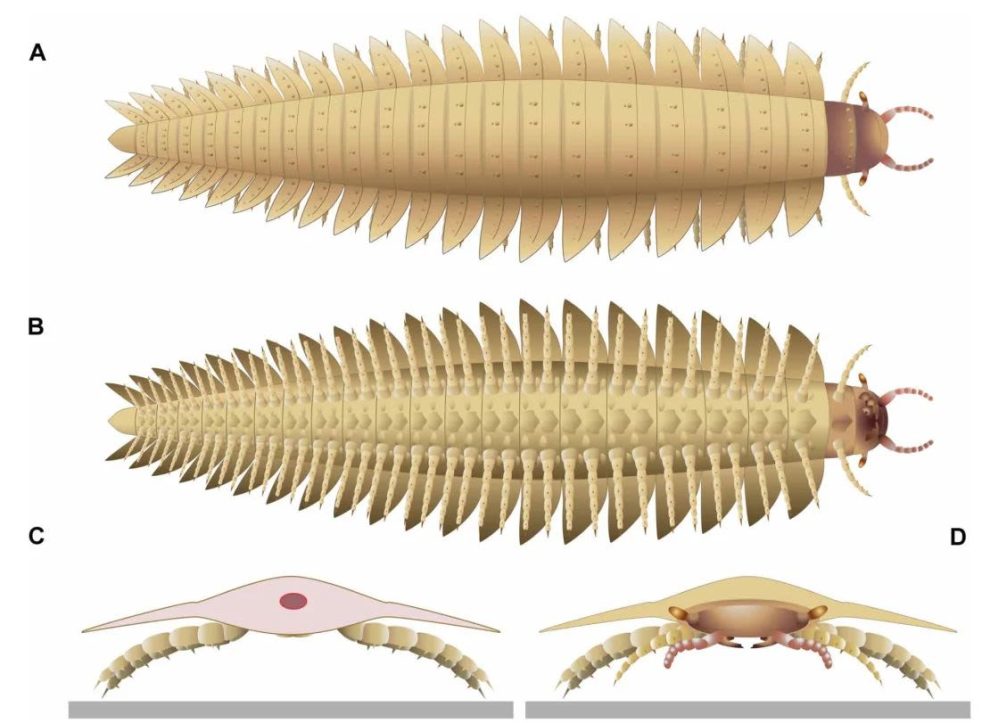() – For nearly two centuries, scientists have tried to solve a persistent mystery about a giant millipede-like animal called Arthropleura, which used its many legs to roam the Earth more than 300 million years ago.
Now, two well-preserved fossils of the creature unearthed in France have finally revealed what Arthropleura’s head looked like, providing insight into how the giant arthropod lived.
Today, arthropods are a group that includes insects, crustaceans, arachnids such as spiders and their relatives, and the extinct Arthropleura remains the largest arthropod known to have lived on the planet.
Scientists in the United Kingdom first found fossils of Arthropleura in 1854, with some adult specimens reaching 2.6 meters in length. However, none of the fossils included a head, which would help researchers determine key details about the creature, such as whether it was a centipede-like predator or an animal that simply fed on decaying organic material, like millipedes. .
In a quest to find the first complete head, researchers conducted an analysis of Arthropleura fossils belonging to two juvenile individuals discovered in the 1970s in France. The findings were published Oct. 9 in the journal Science Advances.
The strange story of Arthropleura took a new turn when the study team scanned the fossils, which are still trapped in stone.
The head of each animal shows features belonging to both millipedes and centipedes, suggesting that the two types of arthropods are more closely related than previously believed, according to the study authors.
“By combining the best available data from hundreds of genes from living species in this study, together with the physical characteristics that allow us to place fossils like Arthropleura on evolutionary trees, we have managed to solve this puzzle. “Millipedes and centipedes are actually each other’s closest relatives,” study co-author and paleontologist Dr. Greg Edgecombe, who is an expert on ancient invertebrates at the Natural History Museum in London, said in a statement.
From fossils and thread-like footprints left behind by Arthropleura, scientists determined that the enormous creature lived between 290 million and 346 million years ago in what is now North America and Europe, and was just one of many giants. that roamed the planet.
An abundance of atmospheric oxygen caused creatures such as scorpions and now-extinct dragonfly-like insects called griffinflies to reach enormous sizes that dwarf their modern counterparts, the study authors said. However, Arthropleura still stood out, reaching about the same length as modern alligators, said the study’s lead author, Mickaël Lhéritier.
Lhéritier is pursuing his PhD in ancient myriapods, a group of arthropods that includes millipedes and centipedes, at Claude Bernard Lyon 1 University in France to understand how arthropods adapted to live on land millions of years ago.
Once the animals died and were buried in layers of sediment over time, some of them became entombed in a mineral known as siderite, which solidified and formed a nodule around the remains. Being encased in stone helped preserve even the most delicate aspects of the fossilized creatures.
Such nodules were first detected in a coal mine in Montceau-les-Mines, France, in the 1970s and were later transferred to French museum collections.
“Traditionally, we would open the nodules and take molds of the specimens,” Edgecombe said. “Today we can investigate them with scans. “We used a combination of microCT (micro-computed tomography) and synchrotron imaging to examine the inside of Arthropleura, revealing the fine details of its anatomy.”
The 3D scans revealed two nearly complete specimens of Arthropleura that lived 300 million years ago. Both fossilized animals still had most of their legs, and one of them had a complete head, including antennae, eyes, jaws and its feeding apparatus, Lhéritier said, making it the first documented head of Arthropleura.
The team was surprised to discover that Arthropleura had body features seen in modern millipedes, such as two pairs of legs per body segment, as well as head features of early centipedes, such as the position of their jaws and the shape of their jaw apparatus. feeding. The creature also had stalked eyes, like crustaceans, Lhéritier said.
In addition to helping researchers better understand what Arthropleura was like, the discovery also establishes a closer evolutionary connection between modern millipedes and centipedes.
Previously, scientists thought the two arthropods were more distantly related, but in recent years, genetic studies have shown that millipedes and centipedes are more closely related.

“This new scenario was criticized by the fact that there was no ‘fossil’ or anatomical argument to defend this grouping, but our new findings on Arthropleura that combine characteristics of both groups tend to confirm this new scenario,” Lhéritier wrote in an email. electronic.
Researchers believe that the two Arthropleura fossils belonged to juveniles because they reach only 25 millimeters and 40 millimeters in length.
Studies of Arthropleura specimens have shown that animals vary in the number of body segments they have, similar to most millipedes adding body segments until they reach a fixed maximum. However, centipedes already have all their body segments in place at birth, according to the study authors.
This finding suggests that Arthropleura reached its maximum segmentation as an adult, rather than at birth. But researchers are interested in determining whether they found true juvenile specimens or a previously unknown smaller species, as well as the growth rate over time for such an animal.
“Footprints found elsewhere in Montceau-les-Mines suggest that these Arthropleura probably measured around 40 centimeters at their maximum length,” Edgecombe said. “Although there is nothing to say they couldn’t be larger, we currently have no evidence of this.”
Now that researchers have discovered a complete head of Arthropleura, they hope the discovery can help them solve other puzzles about the giant animal, including what it ate and how it breathed. However, other fossils will need to be found that preserve additional aspects of the arthropod’s body, including an adult head.
“Although definitive gut contents have not yet been found, other details from these fossils contribute to the debate about Arthropleura’s diet,” Edgecombe said. “They do not have poisonous fangs or specialized legs for catching prey, suggesting that it was probably not a predator. “As their legs are better adapted for slow movement, they were probably more like the detritus-eating millipedes that live today.”
Lhéritier, who is studying another group of ancient myriapods that may have been amphibians, said he is interested in the stalked eyes of Arthropleura.
“Today, stalked eyes are a typical feature of aquatic arthropods such as crabs or shrimp,” he said. “Would it mean that Arthropleura could have been amphibious? To answer this, we need to find the respiratory system of Arthropleura. Finding these organs can help us understand Arthropleura’s relationship with water. Gills like crustaceans would mean an aquatic/amphibious lifestyle, while tracheas (like insects or other myriapods) or lungs (like spiders) would mean a terrestrial lifestyle.”
However, unraveling what Arthropleura’s head looks like solves a key mystery, said James C. Lamsdell, associate professor of geology at West Virginia University, in a related article which appeared in Science Advances. Lamsdell was not involved in the new study.
“These remarkable finds, based on two nearly complete juvenile individuals, present new insight into this enigmatic arthropod,” Lamsdell wrote.
“The most exciting discovery comes from the heads of the specimens that present a mosaic of millipede and centipede characteristics… As the mystery of the affinities of the largest known arthropod is resolved, the work of reconstructing the life history of this creature exceptional can finally begin.”













Add Comment